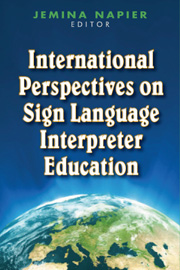Jemina Napier, Editor
|
View the table of contents. View the list of contributors. Read an excerpt. Read a review. |
$75.00s print edition $75.00 e-book |
Interpreter Education, Volume 4
From Interpreting, International Journal of Research and Practice in Interpreting, cont’d.
In the third chapter Lorraine Leeson and Teresa Lynch describe how SL interpreter training evolved in Ireland through several “leaps of faith” such as the development of the Irish Deaf Society, contact in the mid-1980s between the Irish Council of the Deaf and Trinity College Dublin to establish the first programme in ISL (Irish Sign Language), and the establishment of the first SL interpreting agency. “Giant steps” also led to the founding of the Centre for Deaf Studies in Dublin in 2001. Major challenges that remain include establishing the status of ISL in Irish society, and expansion and improvement of existing interpreter training programmes to better fill the growing demand for qualified ISL interpreters.
A different story emerges from Kosovo. Selman Hoti and Susan Emerson recount that the densely populated Balkan country, recently recovering from war, with a historically mixed ethnicity (88% Albanian, together with minority clusters of Serbs, Bosnians, Turks and Roma), is struggling to establish SL interpreter education. As no interpreter training programmes existed in Kosovo prior to 2005—2006 (when one was established at the University of Prishtina in spoken languages), the UN, in need of spoken language interpreters after the war, recruited individuals with no formal training. With the aid of the Finnish Association of the Deaf, a project to fund SLI (in Kosovar Sign Language, KosSL, and Albanian) began in 2005, in which the authors participated. The fledgling course programme is described in depth but its continuation faces great challenges such as the lack of legal recognition of KosSL, a shortage of interpreter trainers, a dearth of teaching resources in Albanian and the need to find the resources to fund it in an academic institution in the future.
Another multilingual country is the Netherlands, where several foreign languages are offered in secondary level education. Immigration, which began in the mid-twentieth century, spurred the growth of interpreting agencies, providing services in a wide range of languages and settings. Onno Crasborn and Tony Bloem outline how SL interpreter services have existed in the country for decades. However, the first formal SL interpreter training was offered in 1997 at the Hogeschool Utrecht, combined with an SL teacher programme, as well as courses offered in deaf-blind interpreting. Dutch interpreters face the problem of widespread dialectal geographical variation amongst both Dutch speakers and signers according to their age and location, and in the latter case, the location of institutes for the deaf. An additional problem is code mixing between spoken Dutch and the sign language of the Netherlands (NGT), such as mouthing, loan words and idioms taken from Dutch. Standardization of NGT has been encouraged by the government as a prerequisite for future official recognition, but so far it has been widely disregarded in interpreter training courses.
The next contribution, by Christine W. L. Wilson and Rita McDade, covers SLI developments in Scotland, where English is the most widely spoken language, with Gaelic, Scots and British Sign Language (BSL) protected as minority languages. The Scottish Parliament promotes linguistic equality across the public sector, encouraging interpreter and translation initiatives, including SLI. BSL is officially recognised in the UK, but, as far as Scotland is concerned, there is still an insufficient number of interpreters available to meet the growing demand. The authors outline the general interpreting environment but focus mainly on BSL/English SLI at Heriot-Watt University, covering ten ‘landmarks’ in detail from the first course in 1996, that has since enabled an interweaving of signed and spoken languages. They touch on issues such as the difficulty of finding placements for BSL students to immerse them in Deaf Culture and the lack of resources for reference and teaching materials.
Jemina Napier is a professor and chair of Intercultural Communication in the Department of Languages and Intercultural Studies at Heriot-Watt University in Scotland.
Print Edition: ISBN 978-1-56368-411-1, 6 x 9 casebound, 328 pages, 7 tables, 16 figures, appendices
$75.00s
E-Book: ISBN 978-1-56368-458-6
$75.00
To order by mail, print our Order Form or call:TEL 1-800-621-2736; (773) 568-1550 8 am - 5 pm CST
TTY 1-888-630-9347
FAX 1-800-621-8476; (773) 660-2235
